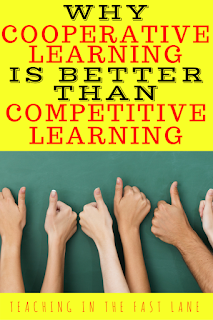What Is Cooperative Learning?
Cooperative learning is more than just group learning or group work. It is strategies that are built with the express purpose of ensuring that all students participating share the work equally and have a vested interest in succeeding. Through cooperative learning structures students are able to hold one another accountable all while working on imbedded social skills and achieving a common goal. In short, cooperative learning activities are a model for real life work experiences that require participants to work together collaboratively with positive interdependence.
 What Is Competitive Learning?
What Is Competitive Learning?
Competitive learning is a more traditional style of learning in which students within the same classroom are competing to participate in an activity. The most prevalent example of this would be when a teacher poses a question to the whole class and students raise their hands to answer the question. This style of learning allows only one student to participate at a time leaving other students to become unengaged or frustrated.
How Do I Get Started With Cooperative Learning?
There are a million and one cooperative learning strategies, but if you are just getting started then I would recommend beginning with a partner strategy such as turn and talk.
Let's look at the same situation discussed above where a teacher poses a question to the class, but instead of having students raise their hands and only one student answer try this:
- Give all students silent think time to formulate an answer.
- Have students share their answer with a partner.
- This could be achieved with a table partner or by finding a partner by stand up hand up pair up or another method.
- After sufficient time has passed as one student to share out what their partner said.
By having students share what their partner said in the end it ensures that they were actively listening to their partner. I would encourage asking several students to share their partner's answers before you discuss the answers as a class.
 The increased engagement provided by the simultaneous conversations going on in the classroom alone are worth their weight in gold to me. I mean, when given the option of engaging one student or your whole class, it seems silly to even think about the former.
The increased engagement provided by the simultaneous conversations going on in the classroom alone are worth their weight in gold to me. I mean, when given the option of engaging one student or your whole class, it seems silly to even think about the former. What More Should I Know About Cooperative Learning Strategies?
If you are looking for more information about cooperative learning basics check out this post where the how and why of cooperative learning strategies is discussed. This is a great resource if you are having to explain to a parent or administrator why you have chosen to include cooperative learning activities in your classroom over more traditional competitive learning strategies.
For an even more in depth approach to cooperative learning check out this Ultimate Cooperative Learning Guide which is updated with new information and posts as it becomes available. This is a great source for the why and how to use cooperative learning strategies as well as a list of cooperative learning structures that I have written about.
Join the newsletter

Subscribe to receive this FREE 7 Continents Jigsaw cooperative learning activity and get started with cooperative learning strategies today!


No comments:
Post a Comment